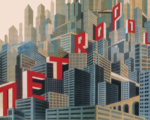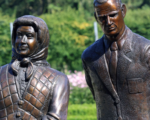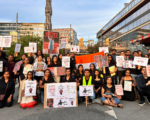On August 9, Kolkata was rocked by the brutal rape and murder of a 31-year-old trainee doctor at RG Kar Medical College. The incident sent shockwaves through the city, sparking accusations of a cover-up, protests, and demands for justice. Daily demonstrations, human chains, and candlelight vigils have become regular sights in the city’s streets. Now, these protests intersect with Kolkata’s biggest annual cultural and religious event, Durga Puja, transforming the festival’s art into a powerful medium of protest.
Durga Puja, the festival that honors the ten-armed Goddess Durga’s victory over evil, has always been a spectacular showcase of art. Traditionally, pandals (temporary temples) display elaborate idols and creative structures, turning Kolkata into a public gallery of street art. But this year, amidst the city’s deepest protests in years, the festival’s art reflects the grief and anger of a community demanding justice.
A Festival and a Movement
The Durga Puja celebrations this year are shaped by the tragedy of the young doctor’s death. The case has not only become a rallying point for justice but has also deeply affected the city’s artists. Prominent visual artist Sanatan Dinda, who has long used his work to reflect societal issues, resigned from a government-run arts organization in protest and joined the street demonstrations. Dinda and other artists from the Kumartuli neighborhood, where Durga idols are traditionally made, have infused their work with a sharper edge, portraying the goddess as a more fierce, confrontational figure. His portrayal of Durga at the Bagha Jatin pandal is especially striking—her lion now springs from her chest, and her ten arms are equipped with spears, symbolizing an intensified battle against evil.
The theme of anger and protest resonates through many pandals. One notable installation at the Kankurgachi puja, titled Lajja (Shame), depicts Durga covering her eyes in sorrow, while her lion stands guard over a woman’s lifeless body wrapped in a white sheet. The emotional tableau is unmistakable—a statement on the systemic failure to protect women, a reflection of the public’s grief.
A Clash of Public Art and Politics
Durga Puja is more than a religious celebration—it is a key economic driver for West Bengal. The festival’s 2019 economic impact was valued at $4.5 billion, nearly 3% of the state’s GDP. However, with this much at stake, artists and organizers must navigate the delicate balance between using the platform for protest and maintaining the celebratory spirit of the festival.
Neighborhood clubs, which organize the pujas, receive financial grants from the government, adding to the complexities of openly addressing sensitive political issues. Some clubs, like those affiliated with opposition parties, have taken a more vocal stance, while others remain cautious. For example, the Arjunpur Amra Sabai Club’s women-led team, which had already planned a Discrimination theme, felt the urgency of the doctor’s murder pushing them further. They have reframed their puja as a “pledge,” rather than a celebration, calling for a world where people no longer need to protest for justice.
Art Imitating Protest
Art as protest is not new, and this year’s Durga Puja draws comparisons to iconic movements in public art. From Jean-Michel Basquiat’s Defacement, which memorialized a police brutality victim, to contemporary figures like Banksy, artists have long used public spaces to provoke political and social reflection. Durga Puja, as one of the largest public art festivals in the world, is the perfect platform for such messages, especially when societal anguish runs so deep.
For some, like renowned artist Susanta Shibani Pal, the intersection of art and protest was inevitable, even if unplanned. His installation Biheen (The Void) immerses viewers in a space resembling a “black hole,” with Durga represented only by a flickering candle, echoing the candles of the ongoing vigils. Pal admits the tragic incident may have subconsciously influenced his work, but he maintains that the piece had already been conceptualized before the protests erupted.
The Spirit of Resistance
While some pandals are transforming into sites of protest, others are taking the protests into their homes. Chandreyee Chatterjee, a regular participant in the street demonstrations, is forgoing much of the usual celebration in her family’s Durga Puja this year. Their observance will be minimal, with rituals performed without the usual festive atmosphere. Instead, she and her friends have created badges emblazoned with a flaming torch and the words “We want justice” in Bengali, which they will distribute during their puja to remind people of the work still ahead.
As the festival unfolds, the intersection of art and protest in Kolkata’s Durga Puja speaks volumes about the power of public expression in times of tragedy. The celebration of Durga, a symbol of the triumph of good over evil, has taken on new layers of meaning in the wake of the doctor’s murder. What was once primarily a joyous occasion is now a platform for collective grief, outrage, and the demand for justice.













